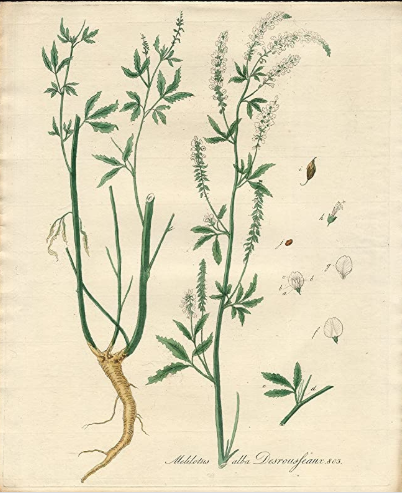
Bokhara Clover [1]
How on earth did my great x 3 grandfather Joshua Rodwell from Alderton near Woodbridge come to be growing Bokhara Clover in 1841?
He had certainly never been within several thousand miles of Central Asia.
If you are fortunate enough to have amongst your ancestors people like Joshua Rodwell who were active participants in society, and who wrote extensively, you might find yourself in the odd position that I am of being able to say that on 9th of September 1841 my great x 3 grandfather had been exhibiting at the Bell Inn at Saxmundham.
Joshua was a keen Improving Farmer and a frequent attendee at the meetings of the East Suffolk Agricultural Association. He had been one of its earliest members taking part since the Association had been founded in 1831.
On the 9th of September 1841, he made had the journey to Saxmundham to attend the Associations annual meeting where he had proudly explained the results of his latest experiments with a new crop, Bokhara Clover.
Bokhara Clover seems to have had a wide native geographical range across Central Asia and much of Mainland Europe. However, I have no idea if had ever been native to England, or indeed if Joshua had been the first farmer here attempt to grow it here.
If you know the answers to either of these questions, I would be very pleased to hear from you.
The following extracts come from a much longer article in the “The Ipswich Journal – Saturday 11 September 1841” [2]
“East Suffolk AGRICULTURAL ASSOCIATION. The tenth anniversary of this excellent association was held at Saxmundham on Thursday last, and the weather being fine, the attendance was numerous, though not quite so large as upon the last occasion, owing principally to the backward state of the harvest. The exhibition of stock took place in a paddock at the back of the Bell Inn;”
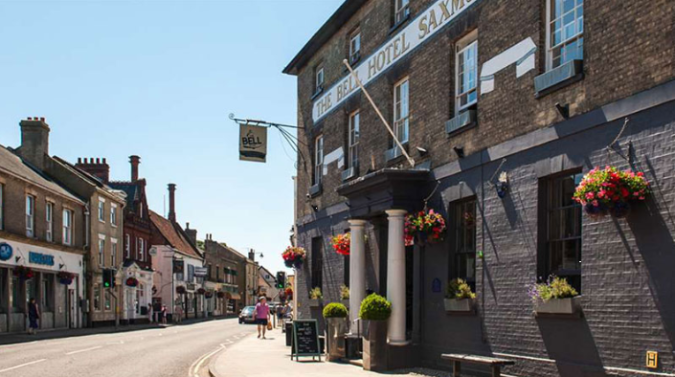
The Bell Inn, Saxmundham [3]
The section of the article that refers to Joshua Rodwell’s experiment is set out below.
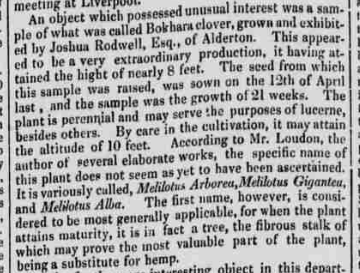
The description from the Ipswich Journal Article describing Joshua’s experiment.
The Mr Loudon referred to in the article was John Claudius Loudon (8 April 1783 – 14 December 1843) a Scottish botanist, garden designer and author.
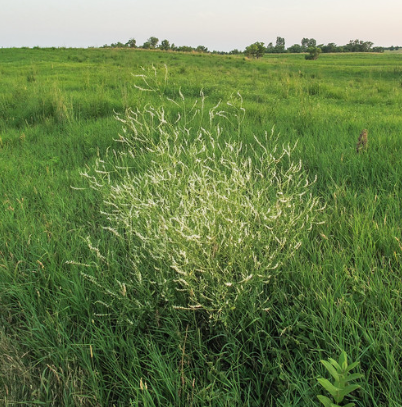
Bokhara Clover
I cannot find a photo of a field under a crop of Bokhara Clover, but I understand that it is seen these days as a pernicious invasive weed across much of south east of the USA.
If the weather had been at all windy or wet, it must have become tangled with wind throw much like Rape does, and must have become very hard and unpleasant to harvest by hand.
Joshua appears to have persisted with the crop for several years because in 1843 a letter of his was read at the Royal Agricultural Society council meeting, although his conclusion, makes one wonder why he had persisted with the crop.
AGRICULTURE.
Bokhara Clover. — At a weekly council of the Royal Agricultural Society of England, held April 26th, a communication was read from Mr. Rodwell of Alderton Hall, Suffolk, on the cultivation and use of this plant. The height of the plant the first year from the seed was 8 feet 11 inches—the second year, in one experiment 11 feet 4 inches, in another, 12 feet 10 inches high. It was sown in drills 18 inches apart, each seed having six inches in the drills. The soil a rich loamy mould, deep and dry; the preparation, deep digging and manuring after potatoes. The spring shoots the second year were growing long before the lucerne was visible. Thus it possesses the advantage of great hardiness, early production, and enormous produce; but unfortunately it seems of very little use; for horses are not fond of it, and cows and pigs prefer other food. A suggestion is thrown out for stacking it in alternate layers without straw, and cutting the two into chaff for use; but it is to be feared that a plant which cattle would not willingly eat would afford them little nourishment. Would it be of value as a green manure?” [4]
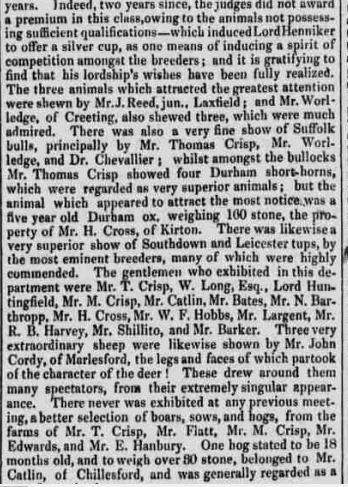
A list of exhibitors at the meeting
One of the most interesting things about these reports of these 19th Century agricultural meetings which are available on the British Newspaper Archive online, are the lists of the exhibitors at these events.
I have collected several dozen of these reports, and some of these names are becoming old friends of mine, as they probably were to by gt… grandfather.
If you know anything about the lives of any of these people, I would be fascinated to hear from you.
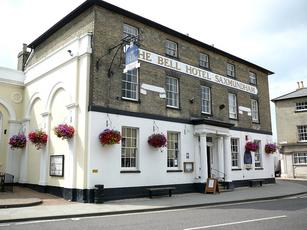
The Bell Hotel as the Bell Inn is now known.
With over 600 visitors to the show, the 9th September 1841 must have seen the town heaving with the farming community, coming in from all the nearby villages and farms.
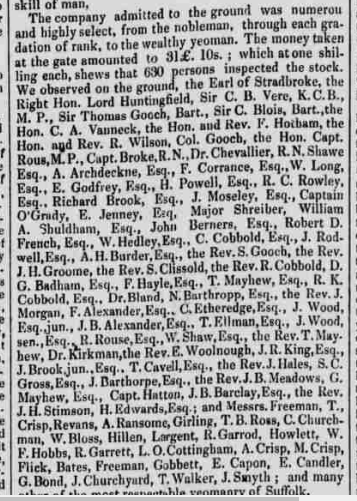
The company admitted to the show
Most of these reports contain lists of the names of the most important attendees at these events. The lists are interesting because the author of the report must have gone to considerable trouble to collect the names.
He then went on to arrange the names into strict order of social precedence, in accordance with the social hierarchy that existed in those days. I expect it was in his interest to get as many of these names into the paper in the expectation, that they would then go out and buy the Ipswich Journal.
Some of the names in this list will be very familiar to you if you know your 19th Century Suffolk history.
Cobbold, Gooch, and R. Garrett, were all very successful at the time in their own careers, but are here overshadowed by the aristocrats and great and good listed at the top.
My 3 x great grandfather doesn’t get into this list.
There was a very interesting group of family historians based in Suffolk formed of members of the Jermyn family. The Dr. Jermyn [5] listed here was the nephew of Henry Jermyn (1767 to 1820) who seems to have been the prime mover in a prolonged effort to record the family history of as many of his neighbours as possible. He had worked in conjunction with his friend David Elisha Davy to record the family histories of most of the upper and middling classes in Suffolk.
His work is preserved in a series of huge hand written, bound ledgers that are held at the British Library. His writing is fantastically neat, and regular over many volumes and hundreds of pages.
Henry Jermyn and David Davy, and later his nephew had written to all the heads of families that made up the most substantial members not just of the great and good, but to most of the more substantial members of the farming community in Suffolk.[6]
Here is a transcript of a letter written to Dr. Jermyn by Joshua Rodwell that sets out how Joshua saw his own position in Suffolk Society.
“Dr. Sir,
I am favoured with your note requesting information respecting my family with a view to making an addition to your genealogical collection. I regret that the particulars of my family are totally devoid of interest & no member of it having to my knowledge stepped out of the ranks of the yeomanry in which we still remain. The only sign of “gentle birth”, is that of the arms used, being the same as those assumed and registered at the College of Arms by a family of the name of Radville, or Radiwell. My mothers family is one of great antiquity in this county for several centuries. A genealogical tree of the family (Medows) is now in the course of Publication by Mr. Taylor.
I am etc. J Rodwell
cop’d May 1840 by GBJ Ipswich 3 April 1840.”
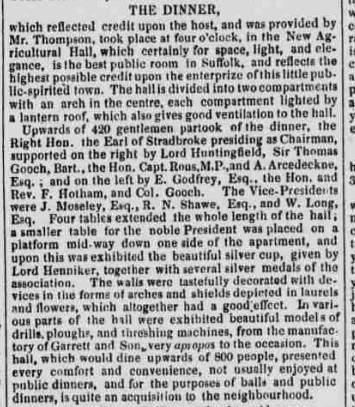
The Dinner at the end of the show
As was usually the case, these events ended up in a huge dinner for most of the participants.
Many were the toasts given, and long speeches were the order of the day.
These are all reported at length (several column feet) in the Ipswich Journal, so I will leave those for you to find.
Did they all stay the night in Saxmundham, or did all these farmers then set off into the time in their gigs, traps or coaches?
Some of them were no doubt three sheets to the wind, by the time the dinner was over.
Joshua had sixteen miles to get home.
If you are able to add to any of the above please contact me at balmer.nicholas@gmail.com
[1] ‘Melilotus alba Desrousseaux. 803.’ – (‘Witte Honingklaver’). Bokhara Clover, Melilotus Albus. from https://www.amazon.co.uk/Antique-Print-BOKHARA-CLOVER-MELILOTUS-ALBUS-803-Flora-Batava-Sepp-1800/dp/B078J4Q1HF
[2] https://www.britishnewspaperarchive.co.uk/viewer/bl/0000071/18410911/012/0004
[3] http://www.beerintheevening.com/pubs/s/13/13160/Bell_Hotel/Saxmundham
[4] Royal Cornwall Gazette – Friday 12 May 1843
[5] Probably Henry Jermyn who was a reknown local genealogist, but possibly his nephew. Page 1. John Batchelor; Lady Trevelyan and the Pre-Raphaelite Brotherhood.
[6] https://en.wikisource.org/wiki/User:Rich_Farmbrough/DNB/H/e/Henry_Jermyn_(1767-1820)












